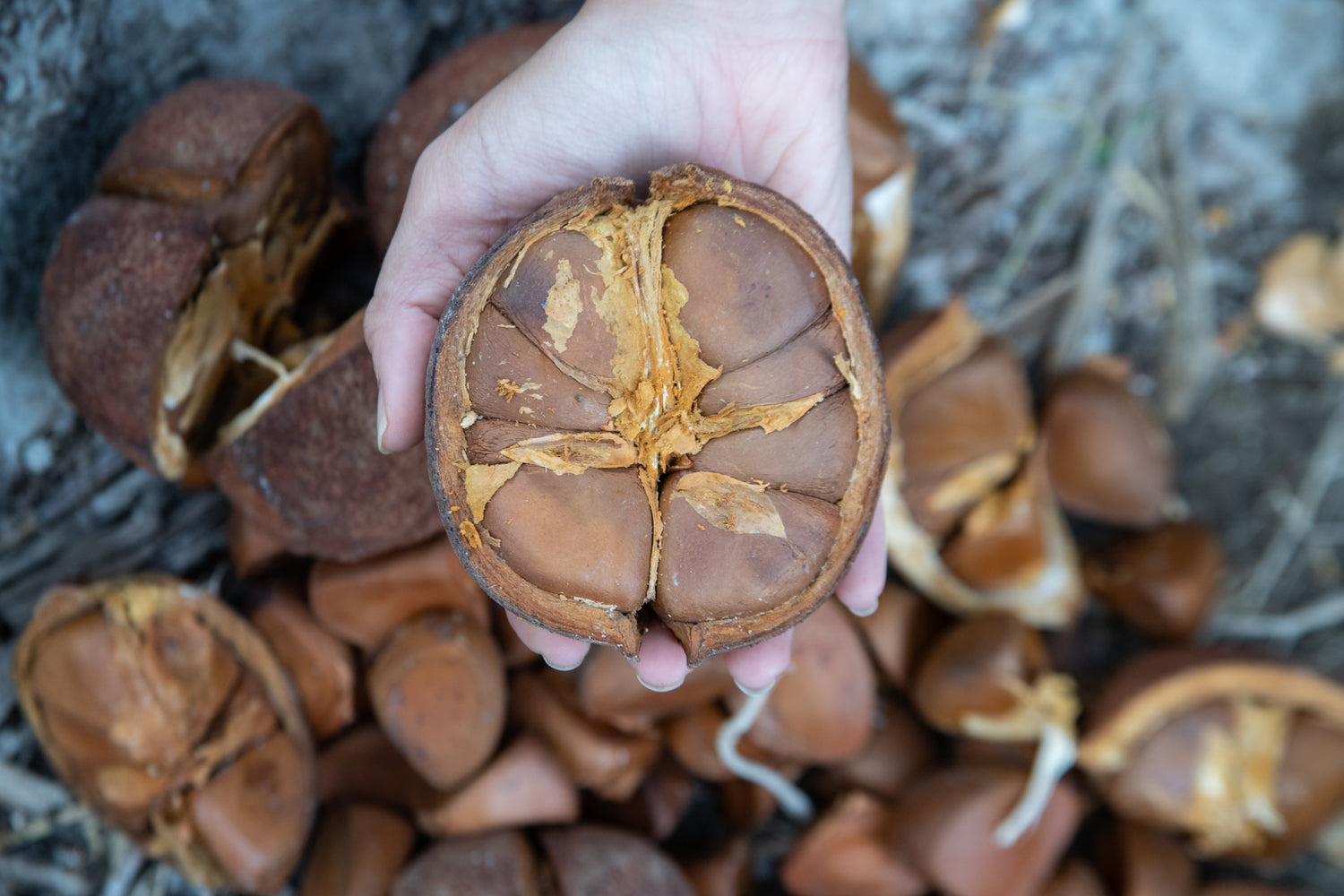
-
A Healthy Ecosystem
Andiroba trees grow wildly in the Amazon Rainforest without the need for fertilizers or pesticides. They coexist with diverse flora and fauna, supporting biodiversity.
Seeds are collected only after they fall naturally, ensuring the tree's health and regeneration.
-
Social Impact
Our producers work with an association of farmers who produce through sustainable management, enabling the development of production chains and socio-bioeconomics in the region.
Its production provides crucial economic opportunities for communities and small-scale farmers. It allows local communities to generate income while maintaining their traditional relationship with the forest. This economic model provides alternatives to more destructive land uses like cattle ranching or clear-cut agriculture. -
The Tree
The Andiroba tree (Carapa guaianensis) is a majestic hardwood native to the Amazon rainforest, found throughout Brazil, Peru, Colombia, and other South American countries.
The tree can reach up to 35 meters in height and produce large, angular seeds that fall naturally when ripe.
Andiroba oil : Usage & Applications
HAIR
Scalp care
Soothes irritation and dryness while helping maintain a healthy scalp environment
Strength & vitality
Reduces breakage, nourishes dry strands, and restores natural shine.
Moisture & Curls definition
Smooths frizz and enhances curl definition for textured hair.
Natural protection
Traditionally used to help prevent lice and repel insects in hair care routines.
SKIN
Calms & restores
Ideal for sensitive and reactive skin, it helps reduce redness, itching, and inflammation.
Nourishes deeply
Improves hydration, elasticity, and suppleness while leaving skin smooth and comfortable.
Natural Insect Repellent
Traditionally used as a natural insect repellent, it brings unique protection benefits in outdoor care formulations.
Supports repair
Aids in skin recovery after sun exposure, shaving, or environmental stress.
Andiroba Oil FAQ: Benefits, Uses & Complete Guide
What is the recommended usage rate of Andiroba oil in cosmetic products?
Creams and lotions: 3–10% for emollient and skin-conditioning effects.
Serums and oils: 5–20% for more concentrated formulations.
Pure treatment oil: 100% application is possible for massage or spot treatment.
For nano-emulsions or liposomal formulations, even 1–3% can deliver significant benefits due to enhanced bioavailability.
Does Andiroba oil require specific emulsifiers?
Andiroba oil is not self-emulsifying, so aqueous formulations require compatible emulsifiers.
It works well with non-ionic emulsifiers such as Polysorbate 80, sucrose esters, or natural systems like lecithin and plant waxes.
Its inherent anti-inflammatory and antioxidant compounds can also help stabilize emulsions, though additional antioxidants (like tocopherol) are recommended for longer shelf life.
Can Andiroba oil clog pores?
Andiroba oil has a moderate comedogenic rating, so those with very oily or acne-prone skin should use it sparingly. However, its antimicrobial properties can actually help prevent breakouts. Always patch test first and start with small amounts to assess your skin's response.
Is Andiroba oil safe for sensitive skin?
While andiroba oil has anti-inflammatory properties that can soothe sensitive skin, its potent active compounds may cause irritation in some individuals. Always perform a patch test by applying a small amount to your inner wrist and waiting 24 hours before full application.
What is a high quality Andiroba oil?
Primegreen's Andiroba oil is of high quality as it is cold-pressed, pure (without additives) and wild harvested to ensure maximum nutrient retention.
How long does Andiroba oil last once opened?
Once opened, andiroba oil typically lasts 12-18 months when stored properly in a cool, dark place. Keep the bottle tightly closed to prevent oxidation. The oil's natural compounds help preserve its stability, but discontinue use if you notice any off odors or changes in consistency.
Can you mix Andiroba oil with other skincare products?
Yes, andiroba oil can be mixed with other natural oils and skincare products. It blends well with carrier oils like Moringa oil. However, due to its potent bioactive compounds, introduce it gradually to your routine and avoid mixing with strong acids or retinoids without professional guidance.
Does Andiroba oil really repel insects?
Yes, andiroba oil has been used traditionally by indigenous Amazonian communities as a natural insect repellent. Its limonoid compounds naturally deter mosquitoes and other insects. While effective, it should be reapplied regularly and may not provide as long-lasting protection as commercial repellents in high-risk areas.
Is Andiroba oil good for inflammatory skin conditions?
Andiroba oil's anti-inflammatory properties make it beneficial for conditions like eczema, dermatitis, and psoriasis. Its healing compounds can help reduce inflammation and promote skin repair. However, always consult with a healthcare provider before using it to treat specific medical conditions.
Is Primegreen's Andiroba oil sustainable and ethically sourced?
Yes, Primegreen’s Andiroba oil is sustainably and ethically sourced directly from local producers in Latin America. As a trusted supplier of natural cosmetic ingredients, Primegreen ensures that its Andiroba oil is harvested through responsible, traceable supply chains that protect biodiversity and support fair partnerships with local communities. Our sourcing model aligns with UEBT standards, guaranteeing ethically sourced ingredients ideal for clean beauty and sustainable skincare formulations.
What's the difference between cold-pressed and refined Andiroba oil?
Cold-pressed Andiroba oil retains all its natural nutrients, vitamins, and beneficial compounds because it's extracted without heat or chemicals. This method preserves the oil's maximum potency. Refined oils undergo processing that strips away many beneficial properties. Our cold-pressed method ensures you receive the highest quality, most effective Andiroba oil with all its natural properties intact.
